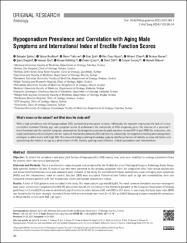| dc.contributor.author | Şahin, Bahadır | |
| dc.contributor.author | Kızılkan, Yalçın | |
| dc.contributor.author | Yldırım, Ömer | |
| dc.contributor.author | Şah, Cem | |
| dc.contributor.author | Kazaz, İlke Onur | |
| dc.contributor.author | Cihan, Ahmet | |
| dc.contributor.author | Duran, Berkan | |
| dc.contributor.author | Ongün, Şakir | |
| dc.date.accessioned | 2024-11-28T12:45:32Z | |
| dc.date.available | 2024-11-28T12:45:32Z | |
| dc.date.issued | 2024 | en_US |
| dc.identifier.issn | 2148-9580 | |
| dc.identifier.uri | https://doi.org/10.4274/jus.galenos.2023.2023.0013 | |
| dc.identifier.uri | https://hdl.handle.net/20.500.12462/15336 | |
| dc.description | Ongün, Şakir (Balikesir Author) | en_US |
| dc.description.abstract | Objective: To detect the prevalence and associated factors of hypogonadism (HG) among men, who were admitted to urology outpatient clinics for reasons other than sexual dysfunction. Materials and Methods: This is a multicentric study designed and conducted by the Turkish Society of Urological Surgery, Andrology Study Group. Male patients between 50 and 75 years of age who were admitted to the urology outpatient clinic for complaints other than sexual dysfunction and whose total testosterone value was measured were included in the study. The correlation between testosterone value and aging male symptoms (AMS) and the international index of erectile function (IIEF) were evaluated. Patient-related factors such as age and comorbidities were also compared between patients with low testosterone values and normal testosterone values. Results: A total of 1021 patients were included in the study. The mean patient age was 69.9±8.6. The most common complaint was non-neurogenic male lower urinary tract symptoms (52.3%). HG prevalence was 38.5% according to the threshold provided in the European Association of Urology guidelines (<12 nmol/L) There was no statistically significant correlation between HG and AMS or IIEF scores. In our study, the body mass index (BMI) was found to be the most strongly correlated factor with serum testosterone levels (r=-0.183, p<0.001) Subgroup analysis revealed the prevalence of HG as 44.9% in men with BMI ≥30 kg/m2. Conclusion: Our results suggest that BMI may be a risk factor for HG, and obese patients may require routine assessment of HG, including serum testosterone measurement and application of symptom questionnaires. | en_US |
| dc.language.iso | eng | en_US |
| dc.publisher | Galenos Yayınevi | en_US |
| dc.relation.isversionof | 10.4274/jus.galenos.2023.2023.0013 | en_US |
| dc.rights | info:eu-repo/semantics/openAccess | en_US |
| dc.rights | Attribution-NonCommercial-NoDerivs 3.0 United States | * |
| dc.rights.uri | http://creativecommons.org/licenses/by-nc-nd/3.0/us/ | * |
| dc.subject | AMS | en_US |
| dc.subject | Testosterone | en_US |
| dc.subject | Andrology | en_US |
| dc.subject | Hypogonadism | en_US |
| dc.subject | IIEF | en_US |
| dc.title | Hypogonadism prevalence and correlation with aging male symptoms and international index of erectile function scores | en_US |
| dc.type | article | en_US |
| dc.relation.journal | Journal of Urological Surgery | en_US |
| dc.contributor.department | Tıp Fakültesi | en_US |
| dc.contributor.authorID | 0000-0002-8253-4086 | en_US |
| dc.identifier.volume | 11 | en_US |
| dc.identifier.issue | 1 | en_US |
| dc.identifier.startpage | 30 | en_US |
| dc.identifier.endpage | 34 | en_US |
| dc.relation.publicationcategory | Makale - Uluslararası Hakemli Dergi - Kurum Öğretim Elemanı | en_US |




















